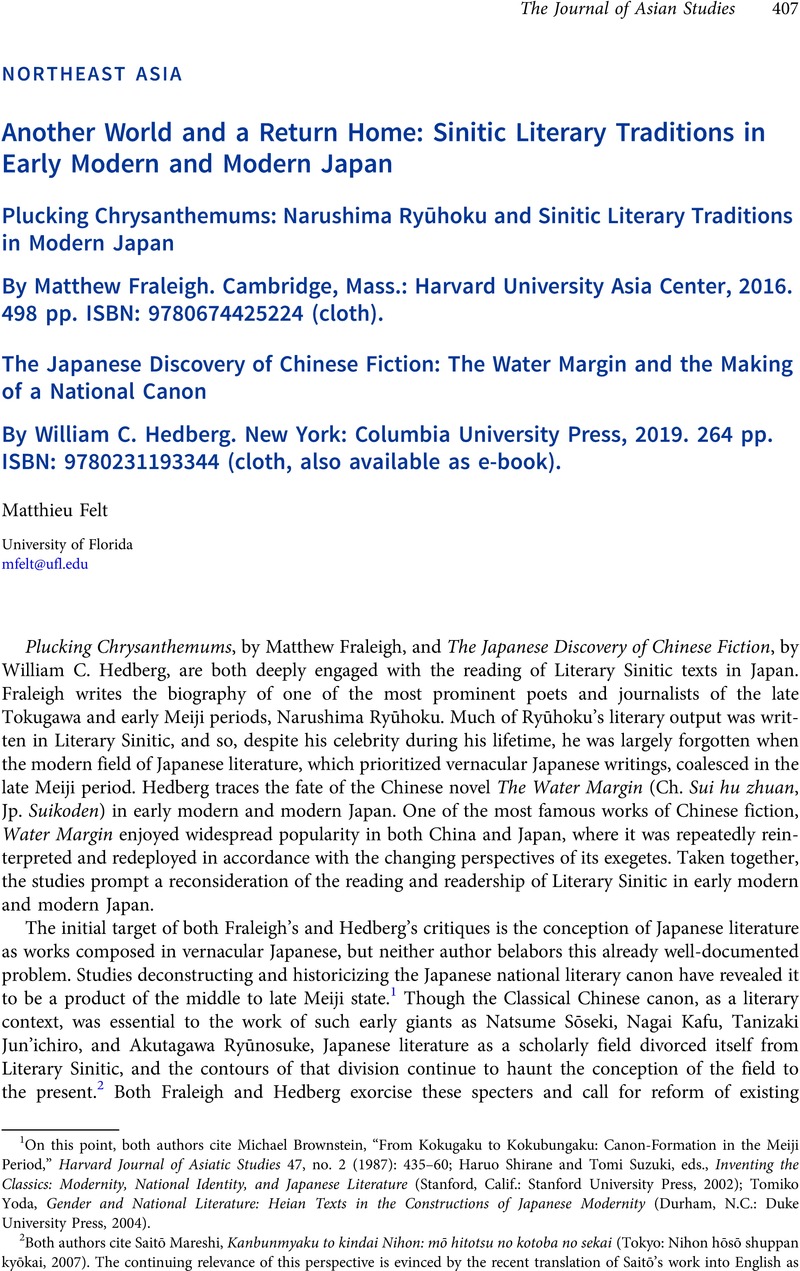No CrossRef data available.
Article contents
Another World and a Return Home: Sinitic Literary Traditions in Early Modern and Modern Japan - Plucking Chrysanthemums: Narushima Ryūhoku and Sinitic Literary Traditions in Modern Japan By Matthew Fraleigh. Cambridge, Mass.: Harvard University Asia Center, 2016. 498 pp. ISBN: 9780674425224 (cloth). - The Japanese Discovery of Chinese Fiction: The Water Margin and the Making of a National Canon By William C. Hedberg. New York: Columbia University Press, 2019. 264 pp. ISBN: 9780231193344 (cloth, also available as e-book).
Published online by Cambridge University Press: 11 May 2022
Abstract

- Type
- Book Reviews—Northeast Asia
- Information
- Copyright
- Copyright © The Association for Asian Studies, Inc., 2022
References
1 On this point, both authors cite Brownstein, Michael, “From Kokugaku to Kokubungaku: Canon-Formation in the Meiji Period,” Harvard Journal of Asiatic Studies 47, no. 2 (1987): 435–60CrossRefGoogle Scholar; Shirane, Haruo and Suzuki, Tomi, eds., Inventing the Classics: Modernity, National Identity, and Japanese Literature (Stanford, Calif.: Stanford University Press, 2002)CrossRefGoogle Scholar; Yoda, Tomiko, Gender and National Literature: Heian Texts in the Constructions of Japanese Modernity (Durham, N.C.: Duke University Press, 2004)Google Scholar.
2 Both authors cite Saitō Mareshi, Kanbunmyaku to kindai Nihon: mō hitotsu no kotoba no sekai (Tokyo: Nihon hōsō shuppan kyōkai, 2007). The continuing relevance of this perspective is evinced by the recent translation of Saitō's work into English as Kanbunmyaku: The Literary Sinitic Context and the Birth of Modern Japanese Language and Literature, ed. Ross King and Christina Laffin (Leiden: Brill, 2021).
3 Emmerich, Michael, The Tale of Genji: Translation, Canonization, and World Literature (New York: Columbia University Press, 2013)CrossRefGoogle Scholar.
4 Fraleigh identifies this “protean” quality of Tao Yuanming across recent work by Xiaofei Tian, Wendy Swartz, and Robert Ashmore.
5 Or rather, was Literary Sinitic, as Hedberg states, characterized by a “general linguistic and cultural ‘Otherness,’ a quality that, as I [Hedberg] demonstrate, it [Water Margin] never entirely shed, no matter how deeply it worked itself into the fabric of Japanese literary culture” (p. xii), or was it the case that, in Fraleigh's words, “the act of writing Sinitic poetry allowed them [men of Ryūhoku's generation] to articulate themselves…a tradition that structured their worlds” (p. 12)?
6 Emmerich, The Tale of Genji, 11.
7 Daigo saishisho suikoden, by Shi Nai'an (Sū Naian) and Jin Shengtan (Jin Sentan), review by Narushima Ryūhoku, notes by Date Kunishige and Habu Ryūhei (Hakuetsudō, 1883; repr., Shōgyokudō shoten, 1894).
8 Consider Emmerich's discussion of Dickinson, Emily; Emmerich, Karen, Literary Translation and the Making of Originals (New York: Bloomsbury Academic, 2017)Google Scholar. Emmerich might contend that publishing figures are also engaging in acts of translation.





